the lower house decided, by ninety-four to forty-six votes, that his execution should take place on 2 Jan. 1645, in spite of the fact that the lords had respited him until the 4th. Hotham was attended on the scaffold by Hugh Peters, and made a speech protesting his innocence and expressing his hope that God would forgive the parliament and the court-martial. He was buried at All Hallows Barking (Rushworth, v. 798–804; Clarendon State Papers, ii. 185; Old Parliamentary History, xiii. 347–359).
Clarendon briefly characterises Hotham as a ‘rough and rude man, of great covetousness, of great pride, and great ambition’ (Rebellion, v. 434). He was ‘a man of good understanding and ingenuity,’ adds Cholmley, ‘yet of a rash and hasty nature, and so much wedded to his own humour as his passion often overbalanced his judgment … he was valiant and a very good friend; and if his own interest had not been concerned would not have forsaken his friend for any adverse fortune’ (Clarendon State Papers, ii. 185).
Hotham married five wives, whose dowries much increased his inherited estate: (1) Katherine, daughter of Sir John Rodes of Barlborough, Derbyshire, 16 Feb. 1606–7; (2) Anne, daughter of Ralph Rokeby, secretary of the council of the north (m. 16 July 1614, d. about 1624); (3) Frances, daughter of John Legard of Ganton, Yorkshire; (4) Catherine, daughter of Sir William Bamburgh of Howsham, Yorkshire, and widow of Sir Thomas Norcliffe, kt. (d. 22 Aug. 1634); (5) Sarah, daughter of Thomas Anlaby of Etton, Yorkshire (m. 7 May 1635) (Foster, Yorkshire Pedigrees, ‘Hotham of South Dalton, Garth’). His son John [q. v.] by his first wife, and his two sons Charles [q. v.] and Durant [q. v.] by his second wife, are separately noticed.
[Authorities cited above. The Clarendon State Papers (ii. 181–6) contain ‘Some Observations and Memorials touching the Hothams,’ written by Sir Hugh Cholmley for the use of Clarendon in writing his Hist. of the Rebellion.]
HOTHAM, JOHN (d. 1645), parliamentarian, son of Sir John Hotham [q. v.], by his first wife, Katherine Rodes, served in early life in the wars in the Netherlands, and is probably the Captain Hotham mentioned as present at the siege of Bois-le-Duc in 1629 (Markham, The Fighting Veres, p. 436). Hotham was member for Scarborough in the two parliaments summoned in 1640. In January 1642, when King Charles endeavoured by means of the Earl of Newcastle to obtain possession of Hull, young Hotham was despatched to secure it. The mayor refused to admit his troops, and he wrote back to the parliament that if he was ordered to proceed, ‘fall back, fall edge, he would put it to the hazard’ (Sanford, Studies and Illustrations of the Great Rebellion, p. 475). A week later he succeeded in garrisoning Hull with a portion of the Yorkshire trained-bands (Rushworth, iv. 496, 564). When actual war began Hotham was again first in the field. In September 1642 he marched out of Hull with three companies of foot and a troop of horse and occupied Doncaster. Refusing to be bound by the treaty of neutrality agreed on by a part of the Yorkshire parliamentarians (29 Sept.), he captured Cawood Castle and published a declaration explaining his reasons for disregarding the treaty (‘The Declaration of Captain Hotham, wherein he showeth the reasons of his Marching into the County of York,’ 1642, reprinted in Dalton, Wrays of Glentworth, ii. 35). He then co-operated with Lord Fairfax in the occupation of Leeds and in the blockade of York (ib. i. 234, 236; Fairfax Corresp. ii. 414–17). Despatched by Fairfax to oppose the march of the Earl of Newcastle from Durham into Yorkshire, he was obliged, after a skirmish at Pierce Bridge, to retreat again to the West Riding (Rushworth, v. 77). He took part in the fights at Tadcaster and Sherburn, and the safe retreat of the parliamentarians at the former is traditionally attributed to a stratagem of Hotham's (Drake, Eboracum, p. 161). By this time serious discord had arisen between the Hothams and the Fairfaxes. Sir Thomas Fairfax complained to his father of Captain Hotham's ‘peevish humour’ (27 Jan. 1643). He had been placed under the command of Lord Fairfax by parliament (21 Oct. 1642), but, though appointed lieutenant-general of his forces, was eager for an independent command, and gladly accepted the post of general of the parliamentary forces in Lincolnshire, which the influence of his connections, the Wrays, obtained him (Fairfax Corresp. iii. 23, 27, 39; Clarendon State Papers, ii. 183). In Lincolnshire he was completely routed by Charles Cavendish on 11 April 1643 at Ancaster Heath (Mercurius Aulicus, 16 April 1643). At the end of May Hotham was at Nottingham, under orders to unite with Cromwell and Lord Gray and reinforce Fairfax in Yorkshire, orders which he was very reluctant to obey (Fairfax Corresp. iii. 46). In Nottinghamshire he allowed his troops to plunder friend and foe, and laughed at all complaints of their conduct. ‘He had a great deal of wicked wit,’ says Mrs. Hutchinson, ‘and would make sport with the miseries of the poor country.’ When Colonel Hutchinson urged him to restrain his soldiers, he replied that ‘he fought
